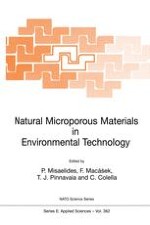
1999 | OriginalPaper | Chapter
Structure and Chemical Characteristics of Modified Clays
Author : P. Komadel
Published in: Natural Microporous Materials in Environmental Technology
Publisher: Springer Netherlands
Included in: Professional Book Archive
Activate our intelligent search to find suitable subject content or patents.
Select sections of text to find matching patents with Artificial Intelligence. powered by
Select sections of text to find additional relevant content using AI-assisted search. powered by
Chemical modifications of various clay minerals from the smectite group are discussed. Acid activation, i.e., partial dissolution of smectites in inorganic acids, is a common treatment applied to produce laboratory samples as well as industrial materials, such as adsorbents, catalysts, etc. The reaction product of an acid dissolution of a clay is independent on the starting mineral used. It is a hydrous amorphous partly protonated high surface silica phase. Proton-saturated smectites, prepared either via mild acid treatment or using ion-exchangers, are unstable materials undergoing autotransformation to their (H,Al,Fe,Mg)-forms. Mildly acid-treated montmorillonites exhibit a high catalytic activity. Acid treatment of tetraalkylammonium cation exchanged smectites produces hybrid catalysts of increased catalytic activity because of the enhanced hydrophobicity of the organoclay. Acid attack of the clay structure occurs not only from the particle edges but also from the interlayers.The negative charge of the layers, arising from the partial non-equivalent substitution of the central atoms in the octahedral and/or tetrahedral sheets, is the most important feature of smectites. It can be chemically increased via structural FeIII reduction or decreased via Li+ fixation. Reduction of structural FeIII to FeII in smectites affects many properties of the clay. Over 90% of structural FeIII in smectites can be chemically reduced. The reduced clays are unstable and undergo reoxidation on air. Another method for modifying the layer charge and thus the properties of dioctahedral smectites is to heat the clay in the presence of Li+, causing the small Li+ ions to enter into the 2:1 layer structure, which decreases the layer charge. A partial stabilisation of FeII in chemically reduced smectites can be achieved via Li-saturation and heating of the reduced clay in an inert atmosphere.